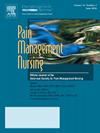Perceived Racial Bias in Medical Settings by Black Adolescents and Young Adults with Sickle Cell Disease
IF 1.6
4区 医学
Q2 NURSING
引用次数: 0
Abstract
Sickle cell disease (SCD) is the most common genetic disorder of people of African descent. The primary reason for healthcare use among people with SCD is for severe acute vaso-occlusive crisis (VOC) pain. However, Black adolescents & young adults (AYAs) are less likely to receive opioids for severe pain. This disparity may be racially motivated.
The purpose of this study is to characterize racial bias events experienced by Black AYAs in community & medical settings. Our aim is to gain a better understanding of racial biases and stress associated with racial bias among Black AYAs.
In this prospective, mixed methods study, we used the 14-item Perceptions of Racism in Children and Youth (PRaCY) questionnaire. Scripted follow-up interviews were conducted by Black young adults who are not health care providers. All study procedures were conducted by phone, recorded, and transcribed using MS Teams. Here we describe initial findings from interviews with 12 Black AYAs with SCD, 10-23 years of age, who received care at an urban, not-for-profit, university-affiliated medical center.
Perceived racial bias in medical settings were reported by 8 of 12 AYAs interviewed. Reports of perceived racial bias were more common in the emergency room (n=5) than a clinic appointment (n=3). Additionally, 4 of the 12 AYAs reported they were treated differently than other children in the hospital. Racial bias was perceived from medical staff rudeness and pain being discounted by HCPs.
The results of this study will help nurses develop effective methods to address differential medical treatment, poor pain management and negative health outcomes experienced by Black AYA because of racial bias in medical settings. Recruitment for this study is ongoing. Content analysis is still needed to identify themes from the post-PRaCY interviews.
求助全文
约1分钟内获得全文
求助全文
来源期刊

Pain Management Nursing
医学-护理
CiteScore
3.00
自引率
5.90%
发文量
187
审稿时长
>12 weeks
期刊介绍:
This peer-reviewed journal offers a unique focus on the realm of pain management as it applies to nursing. Original and review articles from experts in the field offer key insights in the areas of clinical practice, advocacy, education, administration, and research. Additional features include practice guidelines and pharmacology updates.
 求助内容:
求助内容: 应助结果提醒方式:
应助结果提醒方式:


